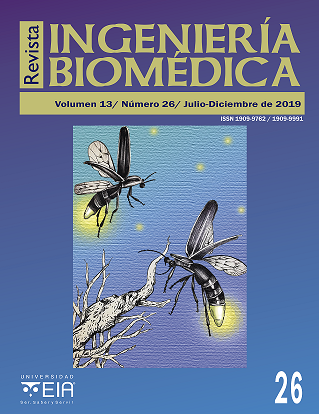Computational dosimetry evaluation in vertebral models using a radioactive bone cement with Sm-153, Ho-166 and Y-90
Computational dosimetry evaluation in vertebral models using a radioactive bone cement with Sm-153, Ho-166 and Y-90
Barra lateral del artículo
Licencia
![]()
Esta obra está bajo una Licencia Creative Commons Atribución-NoComercial-NoDerivativa 4.0 Internacional
Contenido principal del artículo
Resumen
Background: Breast cancer is a disease that affects a large part of the Brazilian female population. Especially, those metastases developed in the spinal column can produce potential fractures with neurological compromise or reduction of the life’s quality of the patient due to chronic pain. Objective: The development of a computational dosimetry in vertebral models simulating bone metastasis applying a radioactive bone cement with Sm-153, Ho-166 and Y-90. Methods: 1. Based on radiological images of animal vertebrae was constructed in the code MCNPx. Absorbed doses were evaluated in the axial plane (XY) of the implant of the radioactive bone cement in the metastasis. The nearest organ of risk (OAR) was the spinal cord and the implant itself on the vertebras was the prescribed tumor volume (PTV). The Sm-153, Ho-166 and Y-90 radionuclides were considered. 2. The fluency of the electrons along the symmetrical axis of the vertebra x = 0 in the z = 0 planes was also studied. Results: The therapeutic absorbed dose obtained in the implant plane by radioactive bone cement reaches levels above 70 Gy for specific activities close to 3 GBq.mg-1 with suitable values for the Y-90 coupled to the cement. Exposure to Ho-166 produces a lower dose than in Y-90 but higher than in Sm-153. The doses obtained by radionuclide implants are better spatial distributed than IMRT, with a significant dose reduction in the spinal cord. Beta emitting from Y-90 found a greater range. Conclusions: The radioactive cement in an implant may potentially favor optimal tumor control and lower side effects in organs at risk.
Descargas
Detalles del artículo
Carlos Julio Montaño Valencia, Universidad Federal de Minas Gerais
Residente posdoctoralBruno Melo Mendes, Centro de desenvolvimento da Tecnologia Nuclear
InvestigadorTarcísio Passos Ribeiro De Campos, Universidad Federal de Minas Gerais
Profesor titularReferencias (VER)
Montaño C.J. and Campos T.P.R. Radioactive cement of pmma and HAp-Sm-153, Ho-166, or Re-188 for bone metastasis treatment. Acta Ortop Bras., 27(1), 64-8, 2019.
Horn E., Henn J., Lemole J., Thoracoscopic placement of dural-rod instrumentation in thoracic spinal trauma. Neurosurgery, 11, 1150-1154, 2004.
Harrington K.D., The use of methylmetacrylate for vertebral-body replacement and anterior stabilization of pathological fracture-dislocations of the spine due to metastatic malignant disease. J Bone Joint Surg Am, 63, 36-469, 1981.
Georgy B.A., Metastatic Spinal Lesions: State-of-the-Art Treatment Options and Future Trends. Am J Neuroradiol, 29, 1605-1611, 2008.
Finlay I.G., Mason M.D., Shelley M., Radioisotopes for the palliation of metastatic bone cancer: a systematic review. Lancet Oncol, 6, 392-400, 2005.
Ryu S., Yin F.F., Rock J., Zhu J., Chu A., Kagan E., Image-guided and intensity-modulated radiosurgery for patients with spinal metastasis. Cancer, 97(8), 2013-2018, 2003.
Ashamalla H., Cardoso E., Macedon M., Guirguis A., Weng L., Ali S., Panigrahi N., Phase I trial of vertebral intracavitary cement and Samarium (VICS): Novel technique for treatment of painful vertebral mastatasis. Int. J. Radiation Oncology Biol Phys, 75, 836-842, 2009.
De la Calle A.B., González-González G., Fornés C., Martínez-Calderón F., 153Sm-EDTMP (SAMARIO) for the treatment of metastatic bone pain. Rev. Soc. Esp. Dolor, 3, 159-163, 2006.
Campos T.P.R., and Macedo R.D., Compósito Ósseo Radioativo, Patent, PI 0605721-7 A2, INPI-Instituto Nacional de Propriedade Industrial (2006), http://www.inpi.gov.br.
Macedo R.D., Radiovertebroplastia para Tratamento de Neoplasias Malígnas óseas da Coluna Vertebral: Avaliação da proposta e da viabilidade. [Dissertation]. [Belo Horizonte-Brazil]: Programa de Ciências Técnicas Nucleares - Universidade Federal de Minas Gerais, Guiding teacher: Campos TPR., 20-61, 2005.
Hirsch A.E., Medich D.C., Rosenstein B.S., Martel C.B., Hirsch J.A., Radioisotopes and vertebral augmentation: Dosimetric analysis of a novel approach for the treatment of malignant compression fractures. Radiotherapy and Oncology, 87, 119-126, 2008.
Dale R.G., The application of the linear-quadratic dose-effect equation to fractionated and protracted radiotherapy. Br J Radiol., 58, 515-528, 1985.
Trinidade B.M., Christóvão M.T., Trinidade D.F.M., Falcão P.L., and Campos T.P.R., Comparative dosimetry of prostate brachytherapy with I-125 and Pd-103 seeds via SISCODES/MCNP. Radiol. Bras, 45(5), 267-272, 2012.
Donanzam B.A, Campos T.P.R., Dalmázio I., and Valente E.S., Synthesis and characterization of calcium phosphate loaded with Ho-166 and Sm-153: a novel biomaterial for treatment of spine metastases. J Mat Sc: Mat in Med, 24, 2873-2880, 2013.
Donanzam B.A., Bioceramicas com Ho-166 e Sm-153: sintese, caracterização e avaliação dosimetrica em radiovertebroplastia. Dissertation, Programa de Ciências Técnicas Nucleares - Universidade Federal de Minas Gerais. Conselho Nacional de Desenvolvimento Científico e Tecnológico. Guiding teacher: Tarcísio Passos Ribeiro de Campos. 26-65, 2012.
Hirsch A.E., Rosenstein B.S., Medich D.C., Martel C.B., and Hirsch J.A., Polymethylmethacrylate and Radioisotopes in Vertebral Augmentation: An explanation of underlying principles. Pain Physician, 12, 887-891, 2009.
Montaño C.J., Nogueira L.B., and Campos T.P.R., Physical distribution and radiological contrast of cements implanted in vitro vertebrae. AP-35. SENCIR 2016. 4-6 October. Belo Horizonte, Brasil, 2016.
Legeros R.Z., Lin S., Rohanizadeh R., Mijares D., and Legeros J.P., Biphasic calcium phosphate bioceramics: preparation, properties and applications. J Mater Sci Mater Med, 14(3), 201-209, 2003.
Pelowitz D.B., Report No. LA-CP-13-00634, MCNP6 USER’S MANUAL v.1.0, 2013
Pelowitz D.B., Report No. LA-CP-11-00438, MCNPX USER’S MANUAL v.2.7.0, 2011
Emami B., et al. Tolerance of normal tissue to therapeutic irradiation. Int J Radiat Oncol Biol Phys, 21(1), 109-122, 1991.
Anselme K., Osteoblast adhesion on biomaterials. Biomaterials, 21, 667-681, 2000.
Hehrlein C., Is Radioangioplasty Next? Catheterization and Cardiovascular Interventions, 57, 295-296, 2002.


 PDF
PDF
 FLIP
FLIP







